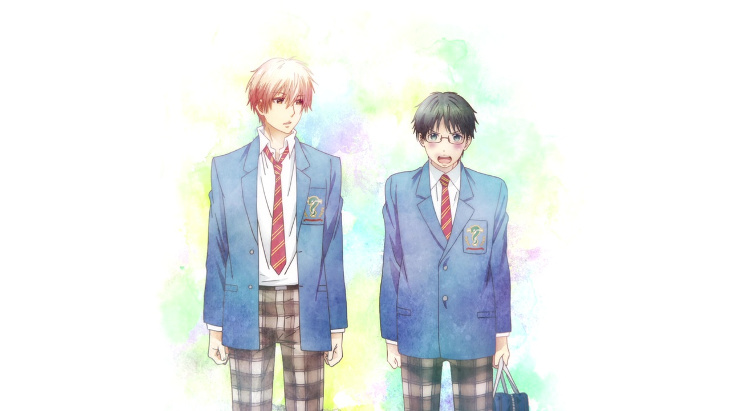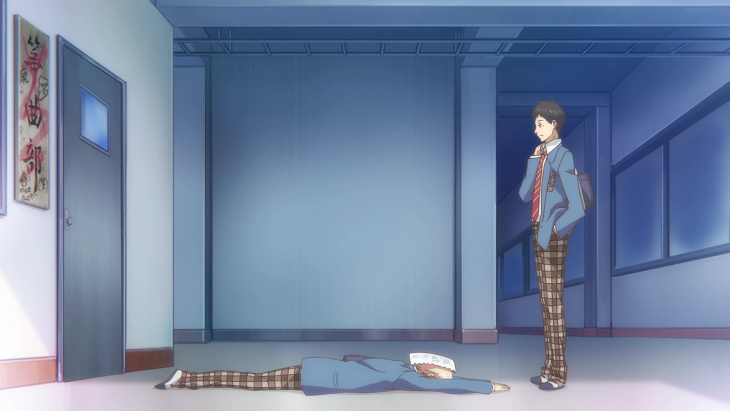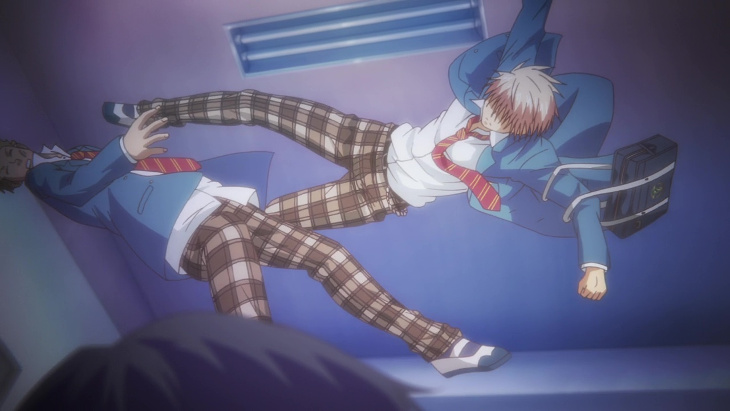
“An old friend of mine actually started this club. So, I wouldn’t like it to disband either.”
I find myself wondering whether this is a sports anime. On a basic level, you can make a “sports” anime out of anything. This is mainly due to the fact that the only real requirement for a sports anime is that it be focused around an activity that could be done competitively, and even then you might have some wiggle room. Do you have a card game based around traditional Japanese poems? Let’s make a sports anime out of it! Ballroom Dancing? It can have a sports anime! Girls trying to knock each other off of floating platforms with their butts? …Yeah, even that can have a sports anime, I guess. I bring this up because Kono Oto Tomare! has an odd subject to build a series around, but this first episode is constructed using the less subtle trappings I would expect from a moderately clunky sports anime. But, I hear you say, isn’t this show about music? Music has competitive elements, but calling it a sports anime seems a bit weird. That would be a reasonable assertion, but Kono Oto Tomare! spends practically none of this first episode’s runtime focused on music. Instead, we’re treated to a twenty minute exploration of the supremely cheesy bond between a club president and his club’s newest member. I’d be lying if I called this premiere unpleasant, but I can’t in good conscience call it good either. Frankly, it’s just Days, but about music instead of soccer. Kono Oto Tomare! is passably average and little more. While I didn’t arrive with heightened expectations, I was still left puzzled by what I ultimately walked away with.

The show follows a high school koto club. I’d seen the instrument before, but had little to no familiarity with it. For those who are similarly unfamiliar, the koto is a stringed instrument that serves as the national instrument of Japan. I learned this from a basic info search, not the show itself. The only bit of koto trivia that the episode provides was that the instrument was designed to look like the back of a dragon. It’s odd to say this about a show centered around music, but I’m not entirely sure whether I even heard a koto during its runtime. The club takes precedence over the instrument during this introduction. There are instances where that approach can work. I alluded to Chihayafuru in the opening paragraph. That series focused on selling the characters to the viewer when it began, but, in doing so, it ensured that said viewer was invested in Chihaya’s passion for karuta. Kono Oto Tomare! had less success on that front. Our central characters are Kurata Takezo and Kudo Chika, who, as of this first episode, serve as the entire membership of the club. Takezo is a meek second-year student who was entrusted with the leadership of the club by his senpais when they departed the year before. Despite his admiration for what the club represents, he finds himself steamrolled by a group of delinquents who have decided the underperforming koto club is a prime location for loitering. This leads to the introduction of Chika, a volatile freshman who has a personal connection to both the club and the instrument. He’s quick to liberate the club from the bullies, but soon find he needs Takezo’s support as well. The key pairing would show promise if it wasn’t for the fact that everything this show does is heavy-handed. Mihashi from Big Windup! would look at Takezo and call him a wimp (probably not to his face), and Chika is the tough, brash student with a heart of gold that appears in every high school setting. I’m fine with a bit of drama, but it all ultimately just felt trite.

The production for this series isn’t bad, but it falls short of what one might expect. From the promo image I saw, I thought I might be in for a P.A. Works style drama with all the gloss and budget that entails. What we actually get is a bit rougher around the edges. The directing and storyboarding of scenes could have used a bit more work, as I actually found minor inconsistencies and production shortcuts to be oddly distracting. For example, when we meet Chika for the first time it is when he kicks one of the bullies in the face with a flying kick. It’s the type of insane maneuver that would probably leave the person who performed it lying prostrate on the ground, but, one convenient cutaway later, Chika is standing calmly in front of the bullies as if he had landed like that a second later. The character modeling itself isn’t bad, but it doesn’t do much to set itself apart from similar fare. At the risk of making a third Chihayafuru reference in a single review, it didn’t help matters that Chika looks like Taichi’s long-lost twin. This is the first anime I’ve watched from the fledgling studio Platinum Vision, and, from the looks of it, one of their only titles that isn’t centered around vampires. I’ve certainly seen better creations, but I’ve also seen worse from both inexperienced and veteran studios alike.
Before I wrap up, a few Notes and Nitpicks:
- I hate the bullies in this first episode. Their plans are the type of arbitrary nonsense that only occurs when the writer needs to move the plot along. Plus, how is it that they’ve trashed and disrespected every aspect of the club room except the large musical instrument housed in there? I’ve been looking back on Hajime no Ippo, and comparisons to Umezawa’s spectacularly written crew are not doing this show any favors.
- Chika comes with an obligatory best friend who is there to provide his backstory to Takezo without being asked.
- This review is a few days late since my computer suffered a Hard Drive failure when I was still halfway through writing this. It has sense been fixed, but the thought of losing a hard drive is always harrowing. I’ll avoid taking out my stress and frustration on this title, and just give this the rating I’d decided on prior to this whole incident, though that isn’t any huge favor in itself.




Add comment